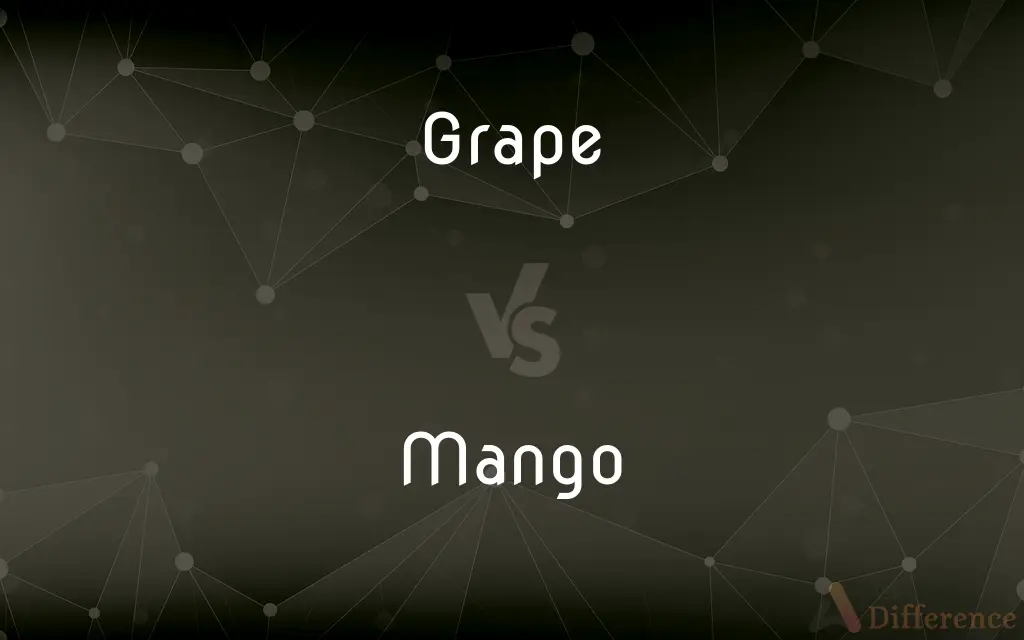Grape vs. Mango — What's the Difference?
Edited by Tayyaba Rehman — By Urooj Arif — Updated on April 26, 2024
Grapes are small, round fruits typically found in clusters and enjoyed fresh or as raisins, wine, and juice, while mangos are large, singular fruits with a sweet, rich flesh, commonly eaten fresh or used in dishes and drinks like smoothies.

Difference Between Grape and Mango
Table of Contents
ADVERTISEMENT
Key Differences
Grapes are commonly available in varieties that range from green to red to black, each with its own distinct flavor profile that can be sweet or tart. Whereas mangos typically have a uniform sweet taste with some varieties offering a slight tartness, and their flesh is more fibrous compared to grapes.
Grapes are often consumed directly as a snack or used in a variety of culinary applications including salads, desserts, and as a base for wines. On the other hand, mangos are frequently used in tropical smoothies, salsas, and as a popular flavor in desserts and sweets.
The skin of grapes is thin and edible, making them easy to consume whole or sliced without peeling. Whereas mangos have a thick skin that is not typically eaten, requiring peeling before consumption.
In terms of nutrition, grapes are a good source of vitamins C and K, and they have high water content. On the other hand, mangos are rich in vitamin A and C, and contain enzymes that aid digestion.
While grapes can be found in both seeded and seedless varieties, making them versatile for consumption and preparation, mangos usually contain a single large seed that must be removed before the fruit's flesh can be eaten.
ADVERTISEMENT
Comparison Chart
Size
Small, round
Large, oval
Color Varieties
Green, red, black
Yellow, green, red
Taste
Sweet to tart
Sweet, sometimes tart
Usage
Snacks, wines, juices, salads
Smoothies, salsas, desserts
Skin
Thin, edible
Thick, not typically eaten
Nutritional Value
High in vitamins C and K
High in vitamins A and C
Seed
Seeded and seedless varieties
One large central seed
Compare with Definitions
Grape
A small, typically round fruit that grows in clusters on vines.
She added both green and red grapes to the fruit salad.
Mango
Commonly eaten fresh, pureed into smoothies, or used in cooking.
Mango salsa is a refreshing accompaniment to grilled fish.
Grape
Consumed fresh, dried as raisins, or fermented to make wine.
He enjoyed a glass of wine made from locally grown grapes.
Mango
Rich in dietary fiber, vitamins A and C, and contains digestive enzymes.
Mangos are not only delicious but also beneficial for digestion.
Grape
A popular choice for healthy snacking due to its natural sweetness.
They packed a bunch of seedless grapes for the picnic.
Mango
A tropical fruit known for its fibrous, sweet flesh and large central seed.
He sliced the mango into cubes for the dessert topping.
Grape
Available in several varieties, each with distinct tastes.
Concord grapes are often used for grape juice and jellies.
Mango
The skin is not edible but the flesh can be cut in various ways.
She used a special technique to cut the mango into hedgehog shapes.
Grape
Contains resveratrol, an antioxidant found in the skin.
The health benefits of grapes include the antioxidant resveratrol in their skins.
Mango
Popular in diverse cuisines, from tropical drinks to spicy chutneys.
Mango chutney is a staple in Indian dining, offering a sweet and spicy flavor.
Grape
A grape is a fruit, botanically a berry, of the deciduous woody vines of the flowering plant genus Vitis. Grapes can be eaten fresh as table grapes, used for making wine, jam, grape juice, jelly, grape seed extract, vinegar, and grape seed oil, or dried as raisins, currants and sultanas.
Mango
A mango is an edible stone fruit produced by the tropical tree Mangifera indica which is believed to have originated from the region between northwestern Myanmar, Bangladesh, and northeastern India. M. indica has been cultivated in South and Southeast Asia since ancient times resulting in two distinct types of modern mango cultivars: the "Indian type" and the "Southeast Asian type".
Grape
Any of various woody vines of the genus Vitis, bearing clusters of edible berries and widely cultivated in many species and varieties.
Mango
A tropical evergreen tree (Mangifera indica) native to Asia, widely cultivated for its edible fruit.
Grape
The fleshy, smooth-skinned, purple, red, or green berry of a grape, eaten raw or dried as a raisin and widely used in winemaking.
Mango
The oval fruit of this tree, having a smooth rind, sweet juicy flesh, and a flat one-seeded stone, and eaten ripe or pickled when green.
Grape
A dark violet to dark grayish purple.
Mango
Chiefly North Midland US A bell pepper, especially a green one.
Grape
Grapeshot.
Mango
A tropical Asian fruit tree, Mangifera indica.
Grape
(countable) A small, round, smooth-skinned edible fruit, usually purple, red, or green, that grows in bunches on vines of genus Vitis.
Grapes give us whole-fruit snacks, grape juice, raisins, wine, and more.
Mango
The fruit of the mango tree.
Grape
A woody vine of genus Vitis that bears clusters of grapes; a grapevine.
Wild grape covering the back slope
Mango
A pickled vegetable or fruit with a spicy stuffing; a vegetable or fruit which has been mangoed.
Grape
(countable) Any of various fruits or plants with varying resemblances to those of genus Vitis but belonging to other genera; their edibility varies.
Sea grape; tail grape
Mango
A green bell pepper suitable for pickling.
Grape
A dark purplish-red colour, the colour of many grapes.
For those seeking purply tones, the paint colors available include mauve, magenta, and grape.
Mango
A type of muskmelon, Cucumis melo.
Grape
(uncountable) grapeshot
Men mowed down by grape
Mango
Any of various hummingbirds of the genus Anthracothorax.
Grape
A mangy tumour on a horse's leg.
Mango
A yellow-orange color, like that of mango flesh.
Grape
A purple-shirted technician responsible for refueling aircraft.
Mango
(uncommon) To stuff and pickle (a fruit).
Grape
A person's head.
Mango
The fruit of the mango tree. It is rather larger than an apple, and of an ovoid shape. Some varieties are fleshy and luscious, and others tough and tasting of turpentine. The green fruit is pickled for market.
Grape
Containing grapes or having a grape flavor.
Mango
A green muskmelon stuffed and pickled.
Grape
Of a dark purplish red colour.
Mango
Large evergreen tropical tree cultivated for its large oval smooth-skinned fruit
Grape
To pick grapes.
Mango
Large oval smooth-skinned tropical fruit with juicy aromatic pulp and a large hairy seed
Grape
(of livestock) To develop tubercules as a result of tuberculosis.
Grape
To develop a texture with small grape-like clusters of a contaminant or foreign substance.
Grape
To grope.
Grape
To envy (derived from "sour grapes" idiom).
Grape
A well-known edible berry growing in pendent clusters or bunches on the grapevine. The berries are smooth-skinned, have a juicy pulp, and are cultivated in great quantities for table use and for making wine and raisins.
Grape
The plant which bears this fruit; the grapevine.
Grape
A mangy tumor on the leg of a horse.
Grape
Grapeshot.
Grape
Any of various juicy purple- or green-skinned fruit of the genus Vitis; grow in clusters
Grape
Any of numerous woody vines of genus Vitis bearing clusters of edible berries
Common Curiosities
What are the health benefits of eating grapes?
Grapes are rich in vitamins C and K and contain antioxidants such as resveratrol.
Can you eat the skin of a grape?
Yes, grape skin is edible and contains nutrients and antioxidants.
How do you properly cut a mango?
Cut along the sides of the central seed, then score the flesh in a grid pattern and scoop it out or turn the skin inside out.
Which fruit is better for making juice, grape or mango?
Both are popular for juices; grapes are commonly used in grape juice and wine, while mango provides a thick, tropical juice.
Is it necessary to peel a mango before eating?
Yes, mango skin is typically not eaten and should be peeled first.
Are seedless grapes genetically modified?
No, seedless grapes are not genetically modified but are the result of selective breeding.
What type of climate do mangos grow in?
Mangos thrive in warm, tropical climates and are native to South Asia.
Can grapes be used in cooking?
Yes, grapes can be roasted, added to salads, or used in desserts and savory dishes.
What dishes are mangos good for?
Mangos are versatile in dishes like smoothies, salads, salsas, desserts, and even some savory dishes.
How long can you store grapes and mangos?
Grapes can be stored in the fridge for about a week, while mangos should be eaten when ripe or can be stored in the fridge for a few days.
Do grapes have a lot of sugar?
Grapes contain natural sugars but also provide nutrients and hydration.
Can you freeze grapes and mangos?
Yes, both can be frozen and enjoyed as a cold snack or used in smoothies.
Which fruit has more fiber, grape or mango?
Mangos generally have more dietary fiber compared to grapes.
What vitamins are most prevalent in mangos?
Mangos are particularly rich in vitamins A and C.
Are mangos good for weight loss?
Mangos are nutritious and can be part of a weight loss diet if consumed in moderation due to their natural sugars.
Share Your Discovery

Previous Comparison
Implement vs. Tool
Next Comparison
First vs. InitialAuthor Spotlight
Written by
Urooj ArifUrooj is a skilled content writer at Ask Difference, known for her exceptional ability to simplify complex topics into engaging and informative content. With a passion for research and a flair for clear, concise writing, she consistently delivers articles that resonate with our diverse audience.
Edited by
Tayyaba RehmanTayyaba Rehman is a distinguished writer, currently serving as a primary contributor to askdifference.com. As a researcher in semantics and etymology, Tayyaba's passion for the complexity of languages and their distinctions has found a perfect home on the platform. Tayyaba delves into the intricacies of language, distinguishing between commonly confused words and phrases, thereby providing clarity for readers worldwide.














































